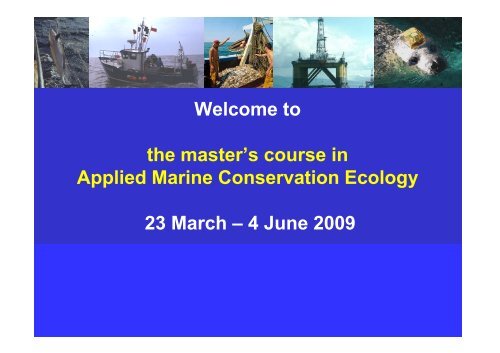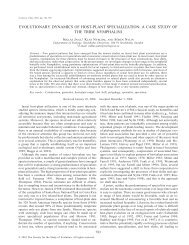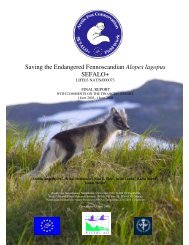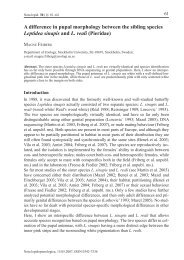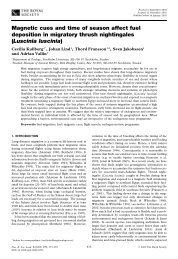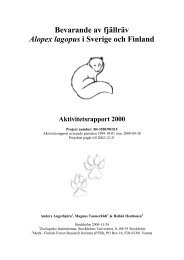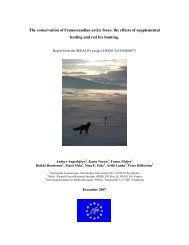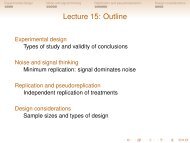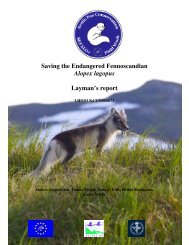Introductory lecture ppt
Introductory lecture ppt
Introductory lecture ppt
You also want an ePaper? Increase the reach of your titles
YUMPU automatically turns print PDFs into web optimized ePapers that Google loves.
Welcome tothe master’s course inApplied Marine Conservation Ecology23 March – 4 June 2009
Todays schedule:• Introduction of the course leaders and students• Introduction to the course and subject area• Start reading the course literature
Applied Marine Conservation EcologyCourse leader:Assistant course leader:Per BerggrenMartin GullströmAssociate ProfessorPhDper.berggren@zoologi.su.se martin.gullstrom@zoologi.su.seTelephone 08-164029 Telephone 08-161358The course will be given in English
Applied Marine Conservation Ecology• This Masters course is aimed at Swedish and overseasstudents interested in a career in marine conservation andmanagement, or a higher academic degree in marine ecology• Students will acquire skills that are desirable to employers• Methods to assess and monitor marine populations will bepresented using marine mammals, fish and other examples• Conservation issues will be investigated in depth andaddressing anthropogenic impacts as part of any situation
Specific course aims are to:• Review marine temperate and tropical habitats• Review information and apply models to assess status ofspecies and habitats• Review methods used to assess distribution, abundance,survival/mortality, population structure, life history parameters,and behaviour of marine vertebrates• Investigate potential effects on marine fish & mammalpopulations and their habitats from human activities e.g.fishing, pollution, tourism, climate change, and infrastructure(e.g. wind farms)
After the course students should:• Have knowledge in how to assess status of marinevertebrate populations as well as marine ecosystems• Be able to identify marine conservation ecology problems• Be able to develop theoretical and practical managementmeasures to solve marine conservation ecology problems• Know how to search, compile, review and presentscientific information to different stakeholders
During the course you will:• Be given <strong>lecture</strong>s by us and other invited experts• Read and discuss a course book• Review and assess scientific information• Have a two week work internship (e.g. SNF, SEPA, SSIC,Fisheries Secreteriat, WWF)• Conduct an individual assignment (e.g. write a review paper,draft management plan, draft project proposal). A moreconstructive alternative to a traditional exam• Practise oral and written presentations
MARINE CONSERVATION BIOLOGY The Science ofMaintaining the Sea's Biodiversity. 2005. 496 PagesEditors: Elliott A. Norse, Larry B. Crowder.• The book brings together leading experts from around the world toapply the lessons and thinking of conservation biology to marineissues• Offers insights of marine biodiversity, what threatens it, and whathumans can and must do to recover the biological integrity of theworld's estuaries, coastal seas, and oceans• Sections examine: distinctive aspects of marine populations andecosystems; threats to marine biological diversity, singly and incombination; place-based management of marine ecosystems; theoften-neglected human dimensions of marine conservation
MARINE CONSERVATION BIOLOGY1. Why Marine Conservation Biology?2. Back to the Future in Marine ConservationPart I. Marine Populations: The Basics3. The Life of the Sea: Implications of Marine Population Biology toConservation Policy4. The Allee Effect in the Sea5. Extinction Risk in Marine Species6. Behavioral Approaches to Marine Conservation
MARINE CONSERVATION BIOLOGYPart II. Threats to Marine Biological Diversity7. The Potential for Nutrient Overenrichment to Diminish MarineBiodiversity8. The Magnitude and Consequences of Bioinvasions in MarineEcosystems: Implications for Conservation Biology9. Diseases and the Conservation of Marine Biodiversity10. Multiple Stressors in Marine Systems
MARINE CONSERVATION BIOLOGYPart III. The Greatest Threat: Fisheries11. Global Fisheries and Marine Conservation: Is CoexistencePossible?12. The Global Destruction of Bottom Habitats by Mobile Fishing Gear13. Effects of Fishing on Long-Lived Marine Organisms14. Evolutionary Impacts of Fishing on Target Populations15. Are Sustainable Fisheries Achievable?
MARINE CONSERVATION BIOLOGYPart IV. Place-Based Management of Marine Ecosystems16. Marine Protected Areas and Biodiversity Conservation17. Marine Reserve Function and Design for Fisheries Management18. Place-Based Ecosystem Management in the Open Ocean19. Metapopulation Structure and Marine Reserves
MARINE CONSERVATION BIOLOGYPart V. Human Dimensions20. Developing Rules to Manage Fisheries: A Cross-CulturalPerspective21. The Role of Legal Regimes in Marine Conservation22. Uncertainty in Marine Management23. Recovering Populations and Restoring Ecosystems: Restorationof Coral Reefs and Related Marine Communities24. Toward a Sea Ethic25. Ending the Range Wars on the Last Frontier: Zoning the Sea
An introduction tomarine conservation biologyIn 1883 the British biologist Thomas Huxley declared:“I believe that the cod fishery, the herring fishery, the pilchard fishery,the mackerel fishery and probably all the great sea fisheries areinexhaustible, that is to say, nothing we can do seriously affects thenumber of fish.”• Unfortunately, Huxley has since been proven wrong• In less then a lifetime, marine fisheries have reduced populations oflarge predatory fishes by 90%• These and other losses led people from a diversity of sciences tostudy ways to prevent loss of diversity. This multi-disciplinary scienceis called: Conservation biology (Soulé and Wilcox 1980)
An introduction tomarine conservation biology• Initially Conservation biology was non-marine• Why? One reason is that we can see the damage on land• Conservation biologists indifference to marine species andecosystems was described first in an issue of Conservation Biologyby Kaufmann (1988) and then more quantitatively by Irish and Norse(1996).• Even to date there have been relatively few papers published onmarine conservation issues (you have a niche to fill!), but things arechanging.• Evidence of biodiversity loss in the seas in the 1990’s• In 1998 (Year of the ocean) 1,605 conservation biologistssigned : Troubled Waters, a Call for Action
Threats to biodiversity• Overexploitation (e.g. fisheries)• Human disturbance (e.g. pollution, war, oil & gas exploration)• Climate change (e.g. coral reef bleaching)• Invasion of alien species:- Deliberate naive introductions- Fugitives (e.g. escapees from aqua culture)- “Hitch hikers” (e.g. in ballast water)• Disease• Natural catastrophe (e.g. Tsunami, ice cover)
Humans have a long tradition of eatingspecies into history and whaling is a good example:• Whales used to be plentiful in most of the world’s oceans• Started in the 1100’s in European seas focusing on slowmoving species e.g. Right and Gray whales• By 1500 needed new hunting grounds after the species hadbeen depleted and found these in the NW Atlantic• Mid 1800s the modern whaling was initiated by the steam shipsand the explosive harpoon – targeting fast moving species• By 1900, species depleted, need for a new hunting ground andthe attention turned to the Antarctic
Humans have a long tradition of eating species intohistory and whaling is a good example:Fishing down the size:Blue whaleFin whaleSei WhaleHumpback whaleMinke whaleMoratorium on whaling in 1986, since then mainly scientificcatches which have been increasing every year
An introduction and history ofmarine conservation biolog• The Gray whale extinct in the Atlantic and next on the list is theNorth Atlantic right whale• Although there has been no hunt of right whales in the NW Atlanticsince 1900. The species show no signs of recovery and today isestimated to < 300 whales• Other examples; Baiji river dolphin and the Vaquita----------------------------------------------------------------------------------------• In our own backyard (the Baltic Sea) there were likely 100,000 greyseals in the early 1900’s and harbour porpoises were also commonuntil the 1970’s
Fishing to extinction – when willhumans learn the lesson?Example 1: Marbled rock cod (Notothenia rosii) around South Georgia,Antartica.• The fishing started in 1970 when 500,000 tons were caught. In thesecond year the population was
Example 2: Cod(Gadus morhua) offNewfoundland,Canada.An overall annual catch of about 250,000 tons for more than a century prior tothe mid-1950s. With the increased effort by distant-water fleets, catchesincreased and peaked at 800,000 tons by 1968.By 1975 the catches were
Example 3:North Sea codIn 2007, a small increasein the number of juvenilecod in the North Sea leadthe International Councilfor the Exploration of theSea (ICES) to notrecommended a zeroquota for the first timesince 2002.In 2008 a 30% increase inthe North Sea cod quotawas agreed but withconditions on catching totake account of thenumber of fish removedfrom the sea rather thansimply landed.
Consequences of losing biodiversity• Ecological function and biological diversity in the sea aredependent on large interactive species (e.g. otters, whales, sealssharks, groupers, cod).• A loss of a large predator that partly regulates the ecosystem maycause an ecosystem shift• The shift could be on one level or have a cascading effect downthe food chain (e.g. Baltic Sea)• Lower resilience of the system• Restoring systems very difficult
Decisionmaking• Define the conservation objective• Use the precautionary principle• Consider the use of statistics:- Hypothesis testing and significance levels- Consequences of Type-I and Type-II errors-The need for Power analysis (does the data & chosen test allow forappropriate testing?)• The need for impact assessments to be conducted prior of the fullscale development (e.g. wind farms)• The need for strong lobbying (e.g. NGO’s)
Is it all doom and gloom?No, there are ways forward• Increased awareness (e.g. Media)• Eco-labelling (e.g. Marine Stewardship Council)• New stronger legislation (EU Habitat’s Directive)• Increased funding for applied science and thematic projects• Alternative socio-economic activities (e.g. Tourism, recreationalfishing)• If the message that the marine biodiversity is thretened and whatimpact this will have on each and everyone is successfullycommunicated to the general public and they in turn express theirconcern to the politicians – this may provide for necessary changes
Course book discussions• You will all take turns at leading the discussion seminars (5 in total)• You should prepare at least 2-3 broader questions that covers thesubject area for each discussion seminar• If you are unable to attend the discussion seminar then we requestthat you hand in a short paper (about 1000 words) where you use thequestions you have prepared and give a short background to thesubject area, review the various arguments and then add your ownthoughts• In order to make these seminars constructive you need to have readand thought about the text. It will result in interesting discussions aslong as everyone has read and participates.
Welcome to Applied MarineConservation Biology!


